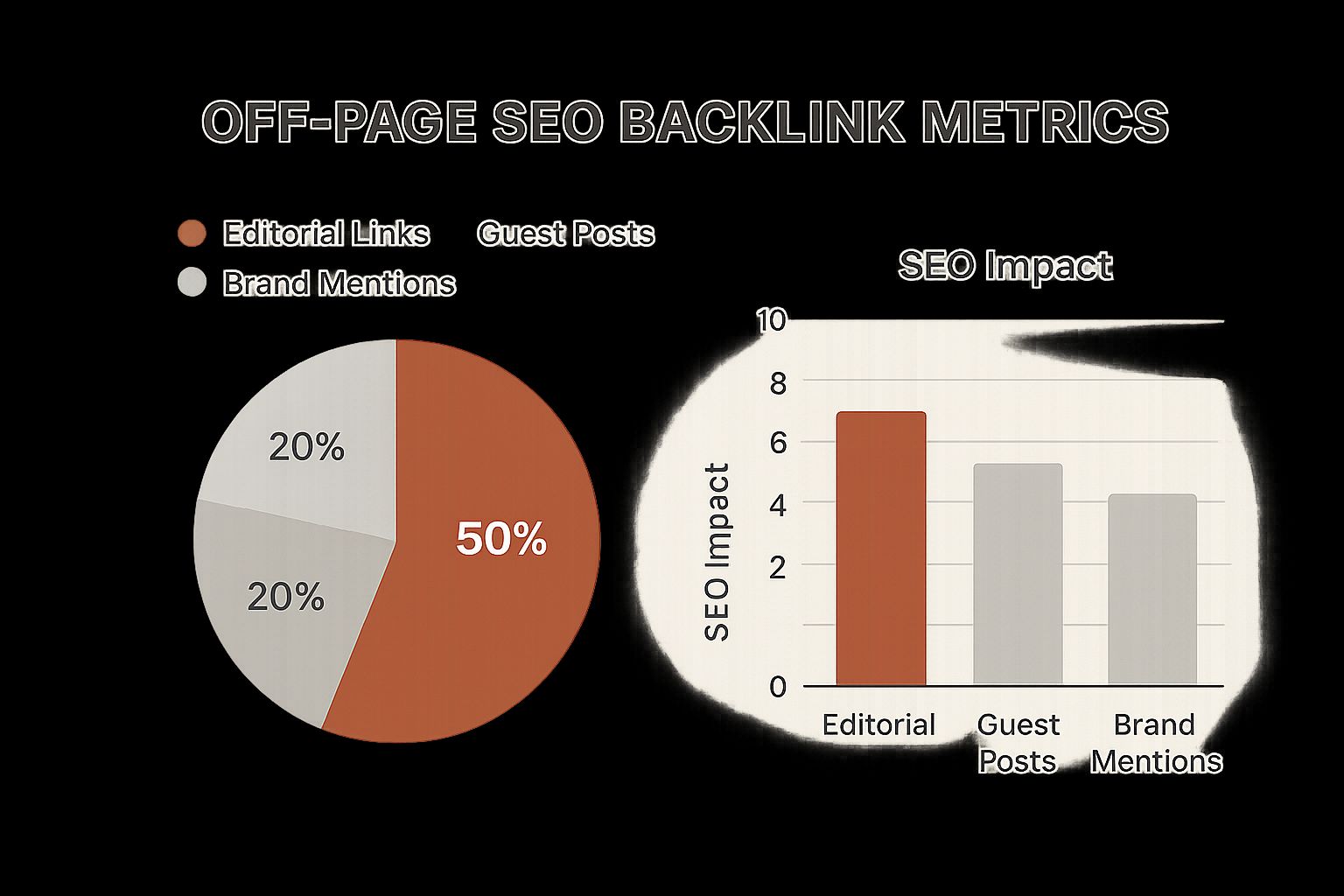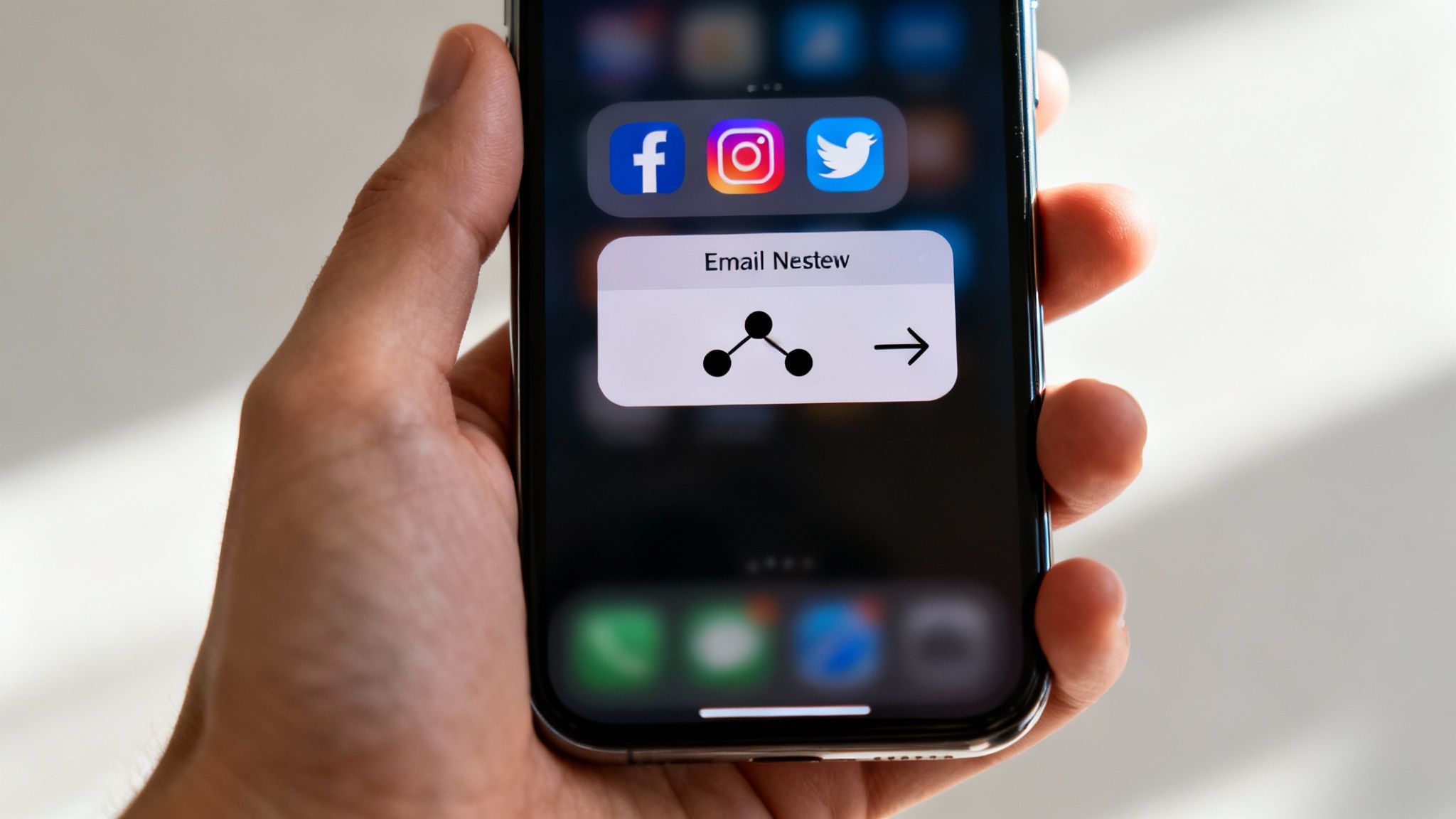If you want to get more people to your website, you need to think bigger than just one tactic. It’s not about a single magic bullet. Instead, it’s a combination of solid on-page SEO, genuinely helpful content, and smart promotion. This is about building a system that attracts the right kind of visitors over and over again.
Build Your Traffic Foundation with On-Page SEO

Before you even think about viral content or big traffic numbers, you have to get your house in order. On-page SEO is that foundation. Without it, anything else you build is going to be shaky. This is your chance to tell search engines exactly what your site is about and why it’s worth a look.
A lot of people get intimidated by SEO, thinking it’s some mysterious art. It’s really just about making your website clear and easy to understand for both real people and search engine bots. If you're new to the concept, our guide explaining what is search engine optimization? is a great place to start.
Master Keyword Research That Works
First things first: stop chasing those massive, high-competition keywords. Trying to rank for something like "small business marketing" is a surefire way to get lost in the crowd. The real wins come from understanding what your specific customers are actually typing into the search bar.
Think about it. A local bakery isn't going to get very far targeting "birthday cakes." But what if they focused on "custom gluten-free birthday cakes in Austin" or "order vegan cupcakes online same day"? These are long-tail keywords. They’re longer, more specific, and reveal exactly what the searcher wants. The search volume is lower, sure, but the traffic you get is far more likely to convert into actual business.
Craft Titles and Descriptions That Earn Clicks
Your title tag and meta description are your first impression in the search results. You can be the #1 result, but if your title is bland, people will scroll right past you. Your job is to be both accurate and enticing.
- Weak Title: "Our Services"
- Strong Title: "Expert SEO Services for Plumbers | Get More Local Leads"
See the difference? The second one immediately tells a plumber what the service is, who it's for, and what they'll get out of it. It connects with a specific need.
Your meta description is where you can elaborate on that promise. Don’t just list features; sell the outcome.
My Go-To Tip: Always put your main keyword in your title tag, ideally toward the beginning. Use the meta description to answer the user’s unspoken question and give them a compelling reason to click through to your page.
Structure Your Content for Readability
Nobody likes hitting a wall of text. Using headings (H1, H2, H3) to structure your content is non-negotiable for both your visitors and for search engines. It breaks everything down into digestible, scannable chunks.
A page should only ever have one H1 tag, which is your main headline. From there, use H2s for the big sections and H3s for the sub-points. This creates a logical outline that helps Google quickly grasp the key topics on your page. This isn't just about looks; it makes your content more user-friendly, which can keep people on your site longer, a big thumbs-up in Google's eyes.
Use Internal Links to Build Authority
I can't stress this enough: internal linking is one of the most powerful and overlooked SEO tactics out there. It’s simply the act of linking from one page on your website to another relevant page. This simple step accomplishes three key things:
- It guides your visitors: Helps them find more of your awesome content, keeping them engaged.
- It spreads link authority: Passes ranking power from strong pages (like your homepage) to other important pages.
- It establishes context: Shows search engines how your pages are related, which builds your site’s authority on a topic.
For example, if you write a blog post on "social media marketing tips," it's a no-brainer to link to your "social media management" service page. As you put these pieces together, you start to see the bigger picture of how to build an online presence that drives growth. Nailing these on-page fundamentals is the crucial first step to getting more traffic that sticks around.
Create Content That Naturally Attracts Visitors

If on-page SEO is the foundation of your website, think of content as everything inside: the furniture, the art, the reasons people want to come inside and stay for a while. It’s the engine that powers your entire traffic strategy.
Great content transforms your website from a simple online brochure into a destination people actively seek out. This isn't about just churning out blog posts to meet a quota. It's about creating genuinely helpful, engaging, and authoritative pieces that solve real problems for your audience. When you get that right, you’re not just chasing rankings; you’re building a community that trusts you and keeps coming back for more.
Identify and Solve Real User Problems
The best content almost always starts with a simple question: "What does my audience actually need help with?" You have to stop guessing and start listening. Pinpoint the specific pain points, burning questions, and daily challenges your ideal customers are facing.
Think about a local accounting firm that works with freelancers. They don't just sell "bookkeeping services." Their audience is up at night worrying about things like "how do I track my business expenses properly?" or "what on earth are quarterly taxes and do I owe them?" By creating detailed guides answering these exact questions, the firm establishes itself as a trusted expert long before anyone even thinks about a sales pitch.
Choose the Right Format for Your Message
Once you know the problem you’re solving, you need to decide on the best way to present the solution. A blog post isn't always the answer. The format you choose should fit what the user is trying to accomplish.
- Deep-Dive Guides: These are perfect for complex topics that need thorough, step-by-step explanations. Think of something like "The Ultimate Guide to Starting an Etsy Shop."
- Case Studies: Fantastic for showing, not just telling. A case study titled "How We Helped a Local Restaurant Increase Bookings by 40%" provides undeniable social proof.
- Checklists and Templates: People love these because they're actionable and highly shareable. A "New Website Launch Checklist" is something your audience will bookmark and use repeatedly.
- Infographics: Ideal for breaking down data or complicated processes into something visually appealing and easy to digest. Plus, they get shared like crazy on social media.
The secret is to match your content type to the reader's intent in that specific moment. Someone searching for "how to" is looking for a guide. Someone searching for proof wants a case study. Give them what they're looking for, and they'll reward you with their time and trust.
When you nail this, you position yourself as the go-to resource in your niche. This approach also happens to align perfectly with how search engines think. Organic search drives about 29% of all website traffic, and since Google dominates the market, you have to play their game. Even more telling is that 73% of all clicks go to organic search results, proof that users trust these non-ad listings far more. You can discover more website traffic statistics and see what they mean for your own strategy.
Refresh Old Content for a Quick Traffic Win
Here’s one of the most effective and overlooked tactics out there: updating your existing content. I guarantee you have old blog posts sitting on your site that are almost ranking on the first page of Google or contain outdated information.
Giving these articles a refresh can deliver a major boost with way less effort than writing something new.
- Update stats and dates: Change "Best Laptops of 2023" to "2024" and swap out any old data for fresh numbers.
- Add new information: Beef up your sections with new tips, more recent examples, or a deeper explanation to make the content more comprehensive.
- Improve the formatting: Break up those long walls of text. Add new images, use blockquotes to highlight key points, and make it easier to scan.
- Check for broken links: Go through and make sure all of your internal and external links are still working.
This process sends a strong signal to search engines that your content is fresh, relevant, and still valuable. It's a simple way to reclaim lost rankings and breathe new life into assets you've already built.
Earn Authority with Strategic Off-Page SEO
Getting your on-site SEO in order is a great start, but it's really only half the battle. To see a meaningful jump in your website traffic, you need to build a solid reputation across the web. That’s where off-page SEO comes into play. It's all about earning trust and authority, which search engines like Google reward with better rankings.
At its heart, off-page SEO is about earning high-quality backlinks. Think of a backlink as a vote of confidence. When another credible website links to your content, it sends a powerful signal to search engines that your material is valuable and worth showing to more people.
The Quality Over Quantity Mindset
Forget the old-school advice about getting hundreds of links from random directories or spammy forums. In modern SEO, one excellent backlink from an authoritative site is worth more than a hundred mediocre ones. Search engines have gotten incredibly sophisticated at understanding context and credibility.
A link from a well-respected industry journal is a massive endorsement. On the flip side, a link from a low-quality, irrelevant blog can actually hurt your rankings. Your goal isn't just to get any link; it's to earn the right links.
This chart breaks down the distribution and impact of different backlink types, showing you exactly where to focus your energy.

As you can see, editorial links, the kind you earn organically because your content is genuinely a great resource, carry the most weight. This really drives home how important it is to create link-worthy assets from the get-go.
Practical Ways to Earn High-Impact Backlinks
So, how do you actually get these powerful "votes of confidence"? It’s not about finding shortcuts; it's about creating real value that other people want to share. Here are a few proven strategies I've seen work time and time again.
- Create Data-Driven Content: Original research, industry surveys, and unique data are absolute backlink magnets. When you publish an article with fresh statistics, you become the primary source. Journalists, bloggers, and industry experts will naturally link back to your study.
- Contribute as a Guest Expert: Writing guest posts for reputable sites in your niche is a classic for a reason. It gets your name and expertise in front of a new, relevant audience and almost always earns you a backlink in your author bio or within the content itself. The key is to provide genuine value, not a thinly veiled sales pitch.
- Pursue "Unlinked" Brand Mentions: You'd be surprised how often people talk about your brand online without actually linking to your site. I recommend setting up alerts for your business name. When you find a mention, just send a friendly email to the author and ask if they’d consider adding a link. It’s a simple ask with a surprisingly high success rate.
Building a strong backlink profile is a marathon, not a sprint. Consistency is everything. Each high-quality link you earn strengthens your website's authority, making it progressively easier to rank for tough keywords and drive reliable organic traffic.
Ultimately, your off-page SEO efforts should be geared toward becoming a recognized authority in your field. By creating citable content, generously sharing your expertise, and building genuine relationships, you’ll naturally attract the kind of backlinks that tell search engines your site deserves to be at the top. This is a non-negotiable step in learning how to increase website traffic for the long haul.
Drive Traffic with Social Media and Email Marketing

So far, we’ve covered how to build a solid SEO foundation so people can find you through search. That's essential, but it's a long-term game. If you want to learn how to increase website traffic now, you can't just build it and hope they come. You have to meet your audience where they already are.
That’s where social media and email marketing come in. These aren't just for building brand awareness; they're powerful tools for pushing qualified, interested visitors directly to your website. It’s all about turning passive followers and subscribers into an active community that clicks, reads, and keeps coming back for more.
Choose Your Platforms Wisely
One of the biggest mistakes I see businesses make is trying to be on every single social media platform. Spreading yourself that thin is a surefire way to get burned out with mediocre results to show for it. The real secret is to be strategic.
Instead of signing up for five different accounts, stop and ask yourself: where does my ideal customer actually spend their time online? If you're a B2B software company, your audience is almost certainly on LinkedIn. A local home decor brand? You'll get way more traction on visual platforms like Instagram and Pinterest.
Don't just chase the latest trend. Go where your audience lives and commit to building a genuine community there. It’s far better to master one or two channels than to be a ghost on five.
Once you’ve picked your platforms, consistency is the name of the game. Showing up regularly with valuable content signals to both the algorithms and your followers that you're a reliable source worth paying attention to.
Create Content People Want to Share
On social media, your content should never feel like a constant sales pitch. The real goal is to create stuff that’s so helpful, interesting, or entertaining that people can't help but share it. That’s how you extend your reach far beyond your own follower count.
Think about how you can slice and dice your existing website content for social media. That in-depth blog post you just wrote can be repurposed into:
- A quick-tip carousel on Instagram highlighting the key takeaways.
- An insightful thread on X (formerly Twitter) breaking down the main arguments.
- A short, engaging video for TikTok or Reels that demonstrates a core concept.
Each piece of social content acts like a breadcrumb, leading people back to your website for the full story. If you're stuck for ideas, our guide on creating engaging social media content offers a great framework for posts that grab attention and drive clicks.
Build and Nurture Your Email List
While social media is fantastic for reaching new people, your email list is an asset you truly own. These aren't just random followers; these are people who have actively raised their hands and said, "Yes, I want to hear from you." That makes them one of your most reliable sources of repeat traffic.
To get started, you need to give people a compelling reason to subscribe. Offer something valuable for free, like a handy checklist, a short e-book, or a discount code, in exchange for their email. Make sure these offers are easy to find on your site, like on your homepage, at the end of blog posts, or in a well-timed pop-up.
But getting subscribers is only half the battle. You have to nurture that relationship. Don't just email them when you want to sell something. Send out a regular newsletter filled with your best content, exclusive tips, and insights they can’t find anywhere else. A well-tended email list is like a traffic-on-demand switch you can flip every time you publish a new article or launch a new product.
To put this all into perspective, different channels serve different purposes. Here's a quick breakdown of where you might want to focus your efforts.
Traffic Channel Focus Comparison
| Channel | Primary Goal | Key Metric |
|---|---|---|
| SEO | Attract organic search traffic | Organic traffic, Keyword rankings |
| Social Media | Build community & drive referrals | Engagement rate, Referral traffic |
| Email Marketing | Nurture leads & drive repeat visits | Click-through rate, Conversion rate |
| Paid Ads (PPC) | Generate immediate, targeted traffic | Cost per click (CPC), Return on ad spend (ROAS) |
| Content Marketing | Establish authority & attract leads | Time on page, New users |
Ultimately, a smart strategy uses a mix of these channels. Social and email are perfect for creating an immediate connection, while your SEO and content efforts build a sustainable foundation for long-term growth.
Make Your Site Flawless on Mobile
https://www.youtube.com/embed/_1p09sTXlE8
Let’s be honest: if your website is a pain to use on a phone, you're practically slamming the door on potential customers. We’re long past the era where mobile was a secondary thought. Today, it’s the main stage.
This isn’t just about having a theme that magically resizes. A true mobile-first approach means you design the entire experience with a smartphone user in mind from the very beginning.
The data backs this up, and it's staggering. A massive 59.7% of all global website traffic comes from mobile devices. Even more telling is that visitors are five times more likely to bail on a site if it isn't mobile-friendly. You can dig into these mobile traffic findings yourself to see just how dominant mobile has become.
Get on Board With Mobile-First Indexing
Google's whole approach to ranking websites has done a complete 180. It used to be that their bots would look at your desktop site to figure out what you were all about. Not anymore.
Now, Google predominantly uses the mobile version of your site for indexing and ranking. This is what we call mobile-first indexing.
What does that mean for you? It means whatever Google sees on the mobile version of your site is your site, period. If you have cool features, important content, or critical links on your desktop version that are missing on mobile, they might as well be invisible to search engines. This is a game-changer if you want to increase your website traffic from search.
Your mobile site isn't the "lite" version anymore. In Google's eyes, it's the real deal. Nailing its performance and content is non-negotiable for serious SEO.
A clunky, slow mobile experience does more than just frustrate users. It sends a direct signal to Google that your site isn’t high-quality, and your rankings will suffer because of it.
Speed and Usability Are Everything
When someone pulls up your site on their phone, they’re not willing to wait. A slow-loading page is the fastest way to lose someone. Every second you make them wait dramatically increases the odds they’ll give up and head over to one of your competitors.
Here's what you need to obsess over for a killer mobile experience:
- Warp-Speed Loading: Crush the size of your images. Get a solid web host. Cut out any code or plugins that are dragging your site down. You should be aiming for a load time of three seconds or less.
- Thumb-Friendly Design: Think about how people actually hold their phones. Are your buttons big enough to tap easily? Can someone navigate your menu without fat-fingering the wrong link? It needs to feel intuitive.
- Text People Can Actually Read: Nobody likes pinching and zooming just to read a sentence. Use a font that's large enough and ensure there’s plenty of contrast between your text and the background.
Put Your Mobile Site to the Test
Don't just cross your fingers and hope your site works well on mobile. You have to test it. Luckily, there are some fantastic tools that let you see your site exactly how a mobile user and a search engine see it.
A great place to start is Google's own Mobile-Friendly Test. Just pop in your URL, and it’ll instantly tell you if you have any major issues.
For a more detailed look, head over to Google Search Console. Its mobile usability report is a goldmine, pointing out specific problems like "Text too small to read" or "Clickable elements too close together."
Beyond the technical tools, look at your own analytics. Isolate your mobile traffic and check the bounce rate, time on page, and conversion rates. If you see mobile visitors leaving way faster than desktop users, that’s your red flag. By finding and squashing these issues, you’ll build an experience that keeps people around and helps you win over the modern web user.
Common Questions About Increasing Website Traffic
You've got the playbook, but growing your website's traffic often brings up some tricky real-world questions. It's one thing to know the strategies, but another to navigate the inevitable roadblocks. This is where we tackle those common hurdles head-on with clear, straightforward advice.
Let’s get into the questions I hear all the time, from timing and tight budgets to those heart-stopping traffic drops.
How Long Does It Take to See SEO Results?
Ah, the million-dollar question. The honest, no-fluff answer is: it depends. SEO is a marathon, not a sprint. While you might see a few little blips of progress in a few weeks, you're typically looking at six to twelve months of dedicated work before you see significant, lasting results.
A few things can really move that timeline:
- Your Industry: Trying to rank for "financial advisor" is a whole different ballgame than ranking for "dog walkers in Boise." The more crowded the space, the longer the climb.
- Your Website's History: A brand-new domain is starting from ground zero. An older site with a solid reputation and clean history has a serious head start.
- Your Content Game: Pushing out one deeply researched, well-optimized article every week will get you there much faster than publishing mediocre content whenever you feel like it.
Think of it like getting in shape. You won't see a six-pack after one trip to the gym. It takes consistency, patience, and doing the right things over and over. Your SEO efforts compound in the exact same way.
What Should I Focus on With a Limited Budget?
When you’re working with a tight budget, you have to be absolutely ruthless with your priorities. You simply can't do it all.
My advice? Pour 100% of your initial focus into killer content and on-page SEO.
This strategy costs you more in time than it does in cash, and you end up building a genuine asset for your business. Start by digging for those low-competition, high-intent keywords that your ideal customers are typing into Google. Then, set out to create the single best piece of content on the internet that answers their question. This becomes the foundation for everything else.
Don't make the mistake of spreading a small budget thinly across a little bit of paid ads, some social media, and a sprinkle of SEO. Go all-in on one thing. Master creating valuable content that ranks, and you'll build a traffic engine that works for you 24/7 without constantly feeding it ad dollars.
Why Did My Website Traffic Suddenly Drop?
Seeing your traffic analytics take a nosedive is terrifying, but don't panic. There's almost always a logical reason. The first move is to play detective with your analytics. Find the exact date the drop happened and start investigating these usual suspects:
- A Google Algorithm Update: Google is always fine-tuning its search algorithm. A big update can seriously shake up the rankings, pushing some sites down while others climb.
- Technical SEO Glitches: Did a recent website update accidentally add a "noindex" tag or mess up your
robots.txtfile? It sounds small, but these technical errors can effectively make your site invisible to search engines. - Lost Backlinks: If a high-authority site was linking to you and suddenly removed that link, you'll feel the impact in both your rankings and referral traffic.
- Tracking Errors: Sometimes, the traffic is still there; you just can't see it. A broken Google Analytics tag or misconfigured tracking code can make it look like your visitors have vanished overnight.
Knowing exactly who is coming to your site (and how) is non-negotiable for real growth. You can learn more from this ultimate guide to tracking website visitors. Once you pinpoint what caused the dip, you can build a smart plan to fix it, whether that means refreshing your content or squashing a technical bug.
At Digital Lotus Marketing, we live and breathe this stuff. We help businesses move past these questions and start seeing real, measurable growth. If you're ready to get some expert help, let's talk. Visit us at https://digitallotusmarketing.com to see how we can build a plan that works for you.





